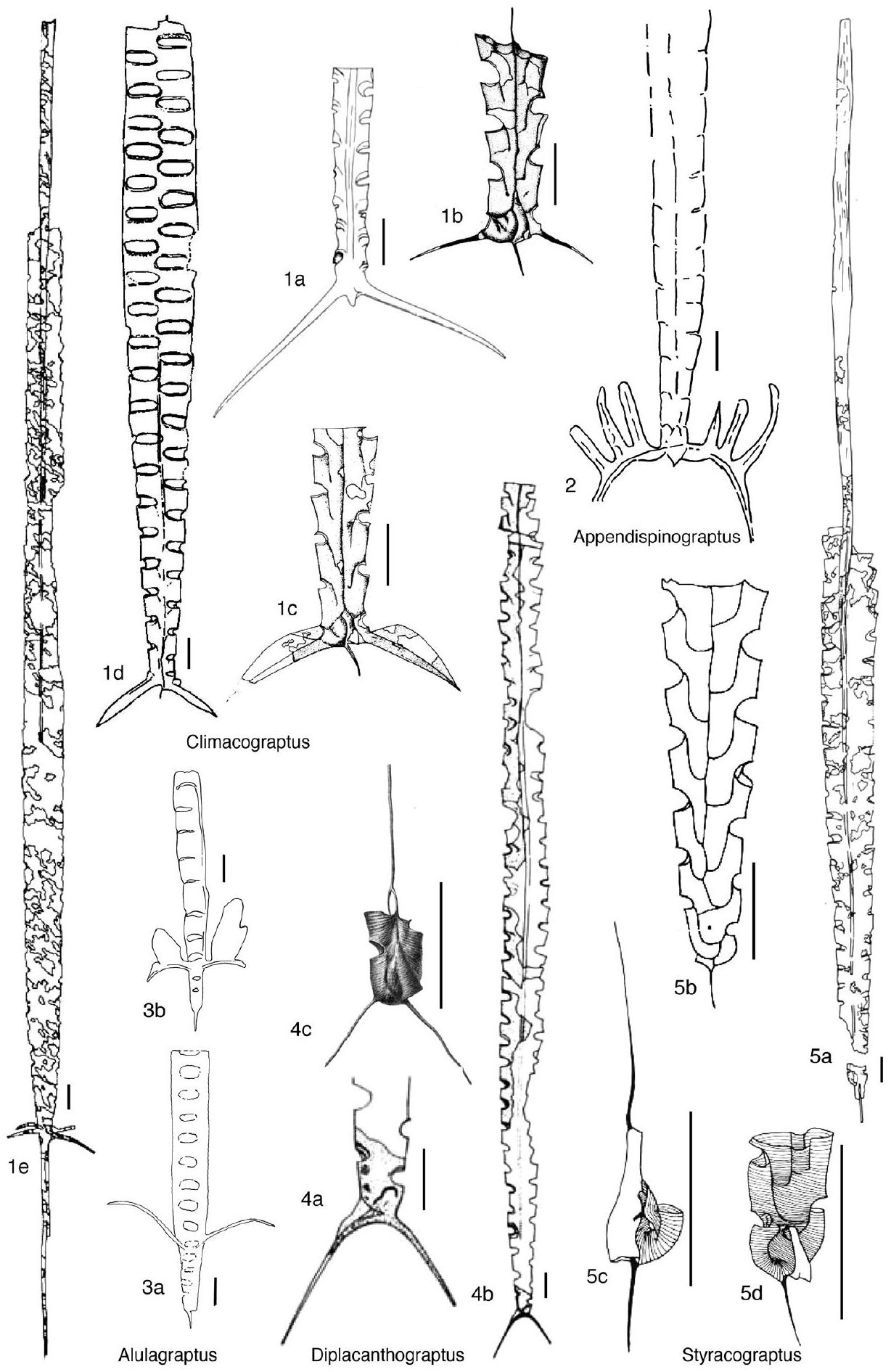Welcome to the Treatise on Invertebrate Paleontology!
Please enter a genera name to retrieve more information.

Diplacanthograptus
Classification
Phylum:
Hemichordata
Class:
Pterobranchia
Subclass:
Graptolithina
Order:
Graptoloidea
Suborder:
Axonophora
Infraorder:
Diplograptina
Family:
Climacograptidae
Formal Genus Name and Reference:
Diplacanthograptus MITCHELL, 1987, p. 388
Type Species:
*Climacograptus spiniferus Ruedemann, 1912, p. 84, OD (=Climacograptus typicalis mut. spinifer RUEDEMANN, 1908, p. 411)
Images
(Click to enlarge in a new window)
Fig. 239,4a-c. *D. spiniferus (Ruedemann), 4a-b, lectotype, AMNH 1041/5a, Utica Shale, Balston Spa, New York, USA (Riva, 1974a, fig. 4), 4c, NRM 1480 (Holm Collection), juvenile showing position of spines on proximal end and the two rods of the prosicula, Kurland, Estonia (Bulman, 1932a, pl. 3). Scale bars, 1 mm
Synonyms
Geographic Distribution
worldwide
Age Range
Beginning Stage in Treatise Usage:
Upper Ordovician (Katian, Pleurograptus linearis Biozone)
Beginning International Stage:
Katian
Fraction Up In Beginning Stage:
0
Beginning Date:
452.75
Ending Stage in Treatise Usage:
Upper Ordovician (Katian, Pleurograptus linearis Biozone)
Ending International Stage:
Katian
Fraction Up In Ending Stage:
100
Ending Date:
445.21
Description
Climacograptids with pattern E astogeny, narrow, asymmetrical proximal end with sicula lying almost entirely to right of tubarium midline in obverse view, sicular aperture oriented at $-70^{\circ}$ from axis and bearing stout (but not necessarily long) virgella deflected across sicular aperture, virgella commonly matched by mesial spine on th $1^{1}$, forming pair symmetrical around tubarium axis in undeformed state, more rarely th $1^{2}$ also bears small mesial spine
References
Mitchell, C. E. 1987. Evolution and phylogenetic classification of the Diplograptacea. Palaeontology 30(2):353-405.
Museum or Author Information
Classification
Phylum:
Hemichordata
Class:
Pterobranchia
Subclass:
Graptolithina
Order:
Graptoloidea
Suborder:
Axonophora
Infraorder:
Diplograptina
Family:
Climacograptidae
Formal Genus Name and Reference:
Diplacanthograptus MITCHELL, 1987, p. 388
Type Species:
*Climacograptus spiniferus Ruedemann, 1912, p. 84, OD (=Climacograptus typicalis mut. spinifer RUEDEMANN, 1908, p. 411)
Images
(Click to enlarge in a new window)
Fig. 239,4a-c. *D. spiniferus (Ruedemann), 4a-b, lectotype, AMNH 1041/5a, Utica Shale, Balston Spa, New York, USA (Riva, 1974a, fig. 4), 4c, NRM 1480 (Holm Collection), juvenile showing position of spines on proximal end and the two rods of the prosicula, Kurland, Estonia (Bulman, 1932a, pl. 3). Scale bars, 1 mm
Synonyms
Geographic Distribution
worldwide
Age Range
Beginning Stage in Treatise Usage:
Upper Ordovician (Katian, Pleurograptus linearis Biozone)
Beginning International Stage:
Katian
Fraction Up In Beginning Stage:
0
Beginning Date:
452.75
Ending Stage in Treatise Usage:
Upper Ordovician (Katian, Pleurograptus linearis Biozone)
Ending International Stage:
Katian
Fraction Up In Ending Stage:
100
Ending Date:
445.21
Description
Climacograptids with pattern E astogeny, narrow, asymmetrical proximal end with sicula lying almost entirely to right of tubarium midline in obverse view, sicular aperture oriented at $-70^{\circ}$ from axis and bearing stout (but not necessarily long) virgella deflected across sicular aperture, virgella commonly matched by mesial spine on th $1^{1}$, forming pair symmetrical around tubarium axis in undeformed state, more rarely th $1^{2}$ also bears small mesial spine
References
Mitchell, C. E. 1987. Evolution and phylogenetic classification of the Diplograptacea. Palaeontology 30(2):353-405.
